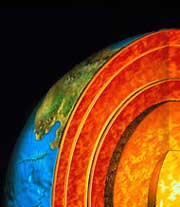Earth could hold more water

A more watery lower mantle would churn faster. <br>© SPL <br>
Five times as much water as in all the world’s oceans may lurk deep below its surface.
Geologists have divined water where you might least expect it: 1,000 kilometres below the Earth’s surface. Here, rocks heated to over 1,000 oC and squeezed under high pressures may harbour around five times as much water as in all the world’s oceans. This could give clues to how the Earth formed and how it behaves today.
Between 650 and 2,900 km below the Earth’s surface hot, compressed minerals surround the planet’s iron-rich core. Called the lower mantle, this material may hold up to 0.2 per cent of its own weight in water, estimate Motohiko Murakami, of the Tokyo Institute of Technology in Japan, and colleagues1.
Theories of planetary formation take into account how much easily vaporized material, such as water and carbon dioxide, were originally present. The findings hint that Earth’s starter mix may have been sloppier than anticipated.
Water would lower the melting point of rocks in the lower mantle and increase their viscosity. Over millions of years, the mantle churns like a pan of hot soup. This moves the tectonic plates and mixes the mantle’s chemical components. A more viscous mantle would churn faster.
The take-up of water by minerals in the lower mantle might also affect the ease with which tectonic plates sink deep into the Earth. As the plates descend, heat up and become squeezed, the water that they release might soften the surrounding mantle and ease their passage.
There is already thought to be several oceans’ worth of water slightly higher in the mantle, at a depth of around 400-650 km. This region is called the transition zone, as it is between the upper and the lower mantle.
The lower mantle’s minerals can retain about a tenth as much water as the rocks above, Murakami’s team finds. But because the volume of the lower mantle is much greater than that of the transition zone, it could hold a comparable amount of water.
“The findings will boost the debate about how much water is locked away in the mantle,” says geologist Bernard Wood of the University of Bristol, UK. Until now, he says, “most people would have argued that there isn’t much water in the mantle”. A similar study two years ago concluded that there isn’t much water down there at all2.
Taking on the mantle
Murakami’s team mimicked the lower mantle in the laboratory. They studied the three kinds of mineral thought to make up most of the region: two perovskites, one rich in magnesium, the other in calcium, and magnesiowustite, a mixture of magnesium and iron oxides.
To recreate the its furious conditions, the researchers used a multi-anvil cell. This heats materials while squeezing them between hard teeth. Having baked the minerals at around 1,600 oC and 250,000 atmospheres, the team measured how much hydrogen the rocks contained using secondary-ion mass spectrometry. This technique blasts the material with a beam of ions and detects the ions sprayed out from the surface.
Any hydrogen in the rocks presumably comes from trapped water, an idea that other measurements support. The researchers found more hydrogen than previous experiments had led them to expect.
References
- Murakami, M., Hirose, K., Yurimoto, H., Nakashima, S. & Takafuji, N. Water in Earth’s lower mantle. Science, 295, 1885 – 1887, (2002).
- Bolfan-Casanova, N., Kepler, H. & Rubie, D.C. Water partitioning between nominally anhydrous minerals in the MgO-SiO2-H2O system up to 24 GPa: implications for the distribution of water in the Earth’s mantle. Earth and Planetary Science Letters, 182, 209, (2000).
Media Contact
All latest news from the category: Earth Sciences
Earth Sciences (also referred to as Geosciences), which deals with basic issues surrounding our planet, plays a vital role in the area of energy and raw materials supply.
Earth Sciences comprises subjects such as geology, geography, geological informatics, paleontology, mineralogy, petrography, crystallography, geophysics, geodesy, glaciology, cartography, photogrammetry, meteorology and seismology, early-warning systems, earthquake research and polar research.
Newest articles

High-energy-density aqueous battery based on halogen multi-electron transfer
Traditional non-aqueous lithium-ion batteries have a high energy density, but their safety is compromised due to the flammable organic electrolytes they utilize. Aqueous batteries use water as the solvent for…

First-ever combined heart pump and pig kidney transplant
…gives new hope to patient with terminal illness. Surgeons at NYU Langone Health performed the first-ever combined mechanical heart pump and gene-edited pig kidney transplant surgery in a 54-year-old woman…

Biophysics: Testing how well biomarkers work
LMU researchers have developed a method to determine how reliably target proteins can be labeled using super-resolution fluorescence microscopy. Modern microscopy techniques make it possible to examine the inner workings…





















